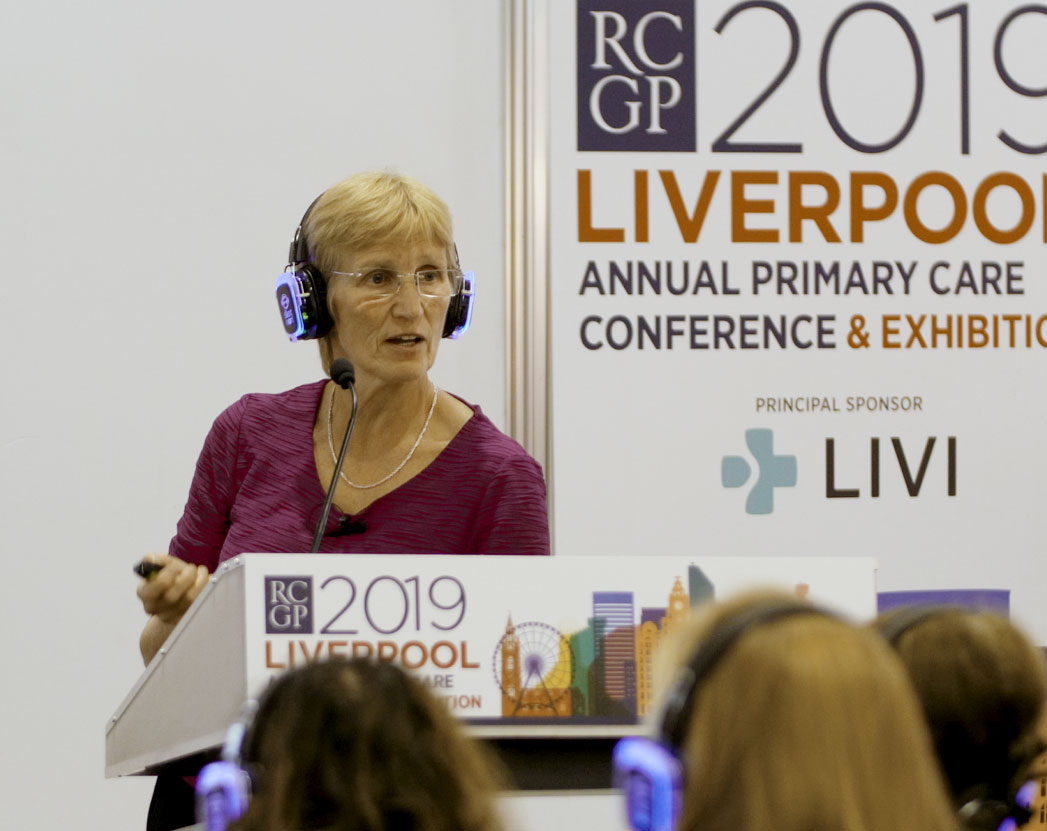Sponsored: How can we best help women with Heavy Menstrual Bleeding?


dr anne connolly
Dr Anne Connolly is GPSI gynae/hysteroscopist, Chair of Primary Care Women’s Health Forum and RCGP Clinical Champion for Women’s Health.
At the RCGP Annual Conference in Liverpool (October 2019), Dr Connolly presented a talk on how we can best help women with heavy menstrual bleeding (HMB) in primary care. In this Q&A, Dr Connolly shares insights from her presentation.
How is heavy menstrual bleeding (HMB) defined?
NICE defines HMB as ‘excessive menstrual blood loss which interferes with a woman’s physical, social, emotional and/or material quality of life. It can occur alone or in combination with other symptoms’.[1]
An estimated one in five women suffer with HMB, with one in 20 women aged between 30-49 years consulting their GP about the issue each year, resulting in around 12% of all gynaecology referrals.[1,2]
What is the personal impact of HMB?
The effect of period problems is underestimated, but has a significant impact on the physical and mental wellbeing of women and girls. A survey of 1,000 women [3] who have experienced HMB found that:
- 74% have experienced anxiety, 69% depression and 49% anaemia
- 72% said it affected their sex life
- 58% feel they are unable to carry out their usual daily routine
- 50% have never been to see a GP about heavy periods
- 62% did not realise heavy periods are a medical condition
What does NICE tell us about HMB?
NICE guidance on HMB was published initially in 2007 with an updated version in 2018.[1] The guideline outlines the need for clinicians to recognise the major impact that HMB can have on a woman’s quality of life and not focus on blood loss alone. The recently published guideline provides additional focus on assessment of individual risk factors requiring examination and investigation and a wider range of treatment options, with a clear focus on the woman’s choice.[1]
Additional tools such as the Wear White Again HMB guide include easy to follow care pathways for diagnosis and management,[4,5] and an excellent endorsed aid for shared decision making.[6]
What is the role of primary care in managing HMB?
History is important to elicit symptoms, assess the impact and any additional risk factors to determine whether examination or investigations are required including:
- the pattern of the bleeding
- related symptoms including intermenstrual bleeding, pelvic pain or pressure symptoms
- the impact that the bleeding is having on her daily life
- other co-morbidities including current treatments and any previous treatments for the HMB
Signposting to relevant information resources including the use of a menstrual diary or app may clarify the concerns and improves awareness of treatment options. I recommend a menstrual diary such as the one found on the Wear White Again website.
How do we determine the cause of HMB?
The majority of women with HMB have no cause found for their problem, but it is essential to exclude structural, histological or coagulopathy before offering treatment.
All women presenting with HMB require a full blood count performed, as anaemia is common and of insidious onset. There is no evidence for routinely checking ferritin, hormone or thyroid function tests in the absence of additional symptoms.[1]
Further investigations are dependent on the findings from the history:
- Women with a lifelong history of HMB or a personal or family history suggestive of a coagulation disorder require a coagulation screen.
- If symptoms suggest uterine enlargement (pelvic pressure or urinary frequency) or endometriosis/adenomyosis (dysmenorrhea or dyspareunia), then a pelvic ultra-sound, preferably a trans-vaginal, scan should be considered.
- If there are concerns requiring endometrial assessment then hysteroscopy is the investigation of choice, these are suggested by:
- History of persistent inter-menstrual bleeding
- Endometrial risk factors
- obesity
- anovulatory cycles of peri-menopause or PCOS
- inadvertently prescribed oestrogen only HRT
- women taking tamoxifen
- failed medical management
- History of persistent inter-menstrual bleeding
- Endometrial risk factors
In the majority of women, the HMB will not be caused by any correctable factors, no investigations are required and treatment can be provided in primary care.
What treatment options are available?
NICE recommend that women should be provided with sufficient information for them to be able to make their own choice about treatment options and be able to access these in a timely manner.[6]
Once additional pathology has been excluded, treatment options are dependent on ongoing fertility requirements, treatment efficacy and risks, social impact associated with treatment and recovery time and patient choice. There is a requirement to provide reliable information resources to enable informed choice of treatment options. Providing short acting treatment with tranexamic acid to reduce menstrual loss while waiting to access treatment or decide is recommended by the NICE HMB quality standard.[7]
Recommended treatments[1]
Hormonal (and therefore deemed to be contraceptive)
- LNG-IUS
- Combined hormonal contraception
- Long-cycle progestogens
Non-hormonal
- Tranexamic acid
- Non-steroidal anti-inflammatory drugs
Surgical (non-reversible)
- Endometrial ablation e.g. NovaSure®
- Hysterectomy
If investigation by hysteroscopy is required, NICE recommend this should be performed in the outpatient setting offering one-stop treatment procedures, including LNG-IUS insertion or endometrial polyp morcellation e.g. MyoSure® if required and chosen.
NovaSure® is a second-generation endometrial ablation procedure which is well tolerated in the out-patient setting, with an average treatment time of 90 seconds, with good outcomes for women opting for a surgical procedure.
What resources are available to help primary care healthcare practitioners diagnose and manage HMB?
Keeping up to date with latest guidelines is difficult for busy primary care clinicians. The RCGP in conjunction with Endometriosis UK, RCOG, FSRH, BMS have developed an easy to access resource ‘The Menstrual Wellbeing Toolkit’ where latest guidance, patient information, education and commissioning resources are found in one place to help during consultations for menstrual dysfunction.[8]
The Wear White Again website: www.wearwhiteagain.co.uk is a useful resource, with information and support for healthcare professionals and patients requiring information about their HMB and treatment options. Wear White Again is a Hologic campaign.
Key Points
HMB is a commonly presenting problem which causes considerable distress to women.
History of the concern is essential to determine which, if any, investigations are required prior to treatment.
There are a number of successful treatment options available for HMB, but women require reliable, evidence based information to be able to make their treatment choices.
Newer surgical treatment options, including NovaSure® and MyoSure® allow women the option of minimal intervention surgery in the out-patient setting.
References
[1] NICE. Heavy menstrual bleeding: assessment and management. NG88. March 2018. Available at: www.nice.org.uk/guidance/NG88
[2] Philipp C, Faiz A, Dowling N et al. Age and the prevalence of bleeding disorders in women with menorrhagia. Obstet Gynecol 2005; 105 (1): 61–66
[3] Data on fi le: MISC-05659-GBR-EN Rev 001.
[4] NICE. Heavy menstrual bleeding: assessment and management. NG88. March 2018. Diagnosis care pathway. Available at: https://www.nice.org.uk/guidance/ng88/resources/diagnosis-care-pathway-pdf-4783791277. Last accessed 8 October 2019.
[5] NICE. Heavy menstrual bleeding: assessment and management. NG88. March 2018. Management care pathway. Available at: https://www.nice.org.uk/guidance/ng88/resources/management-care-pathway-pdf-4783791278. Last accessed 8 October 2019.
[6] Endorsed resource – Shared decision making aid for heavy menstrual bleeding. Available at: https://www.nice.org.uk/guidance/ng88/resources/endorsed-resource-shared-decision-making-aid-for-heavy-menstrual-bleeding-6540669613. Last accessed 8 October 2019
[7] NICE HMB QS 47 Updated 2018. Available at: https://www.nice.org.uk/Guidance/QS47. Last accessed 8 October 2019.
[8] RCGP Menstrual Wellbeing Toolkit. Available at: https://www.rcgp.org.uk/menstrualwellbeingtoolkit. Last accessed 8 October 2019.
Wear White Again is a Hologic campaign
SOM-00766-GBR-EN Rev 001

35311 1i stock 2
Pulse July survey
Take our July 2025 survey to potentially win £1.000 worth of tokens

Visit Pulse Reference for details on 140 symptoms, including easily searchable symptoms and categories, offering you a free platform to check symptoms and receive potential diagnoses during consultations.













